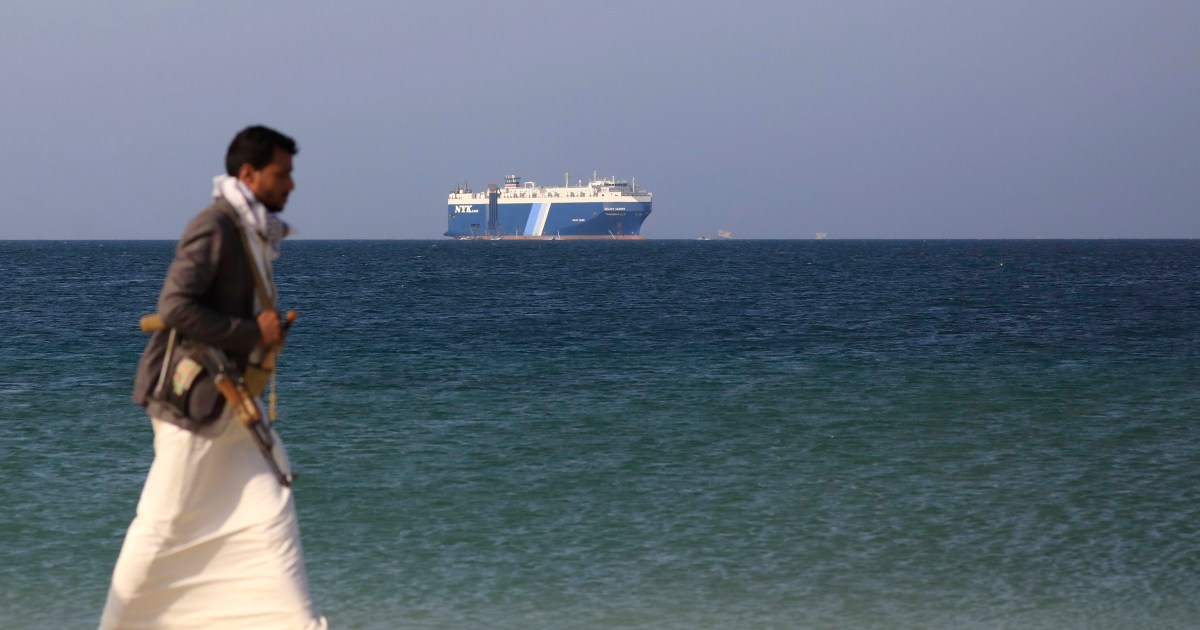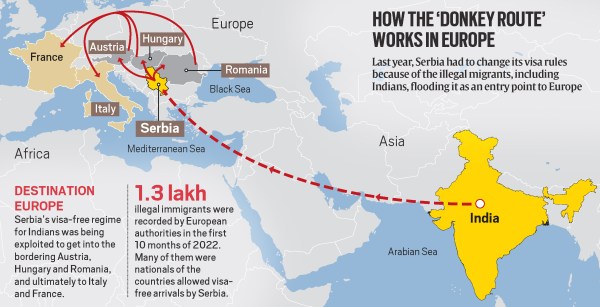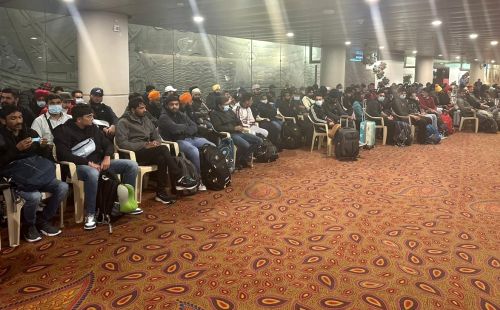Note4Students
From UPSC perspective, the following things are important :
Prelims level: Bab al Mandab Strait

Central idea
The central idea focuses on the Houthi threat to Red Sea shipping, emphasizing the importance of navies and diplomatic efforts to maintain stability in the Indian Ocean. Historical trade warfare context and the need to address challenges like drone warfare underscore the urgency in safeguarding international trade routes. India’s proactive role and diplomatic leverage play a crucial role in ensuring regional stability.
Key Highlights:
- Houthi rebels, post the October 7 Hamas attack on Israel, pose a threat to Red Sea merchant-shipping traffic.
- Alfred Mahan’s emphasis on navies as a means to protect foreign trade and commerce for national prosperity.
- Indian Ocean’s vital role in global economy with 1,00,000 annual merchantmen, carrying 80% of the world’s oil.
- Indian Navy’s proactive role as a “preferred security partner” in maintaining good order at sea.
Key Challenges:
- Rising threat to Red Sea shipping by Houthi rebels affecting global trade.
- Historical instances of trade warfare impacting security and prosperity.
- Critical choke points in the Indian Ocean vulnerable to interdiction by states, pirates, and terrorists.
Key Terms and Phrases:
- Choke points: Narrow passages in the Indian Ocean constricting shipping traffic.
- Tanker war: Strategy targeting merchant ships to impact trade, as seen in the Iran-Iraq conflict.
- Flag state: State in which a ship is registered, exercising exclusive jurisdiction over vessels.

Key Quotes:
- “The necessity of a navy… springs from the existence of peaceful shipping…”
- “The Indian Navy’s self-assigned role of ‘preferred security partner’ in the region.”
Anecdotes:
- Eight-year-long Iran-Iraq conflict saw a “tanker war” impacting merchant ships in the Persian Gulf.
- Houthi rebels launching attacks on US Navy units and merchant shipping in the Bab al Mandab Strait.
Key Statements:
- Indian Navy’s commendable alacrity in responding to emergent situations in the Red Sea.
- US launching operation “Prosperity Guardian” to safeguard Red Sea shipping.
Key Examples and References:
- Germany targeting Allied merchant shipping in 20th-century global conflicts.
- Houthi attacks in the Bab al Mandab Strait affecting merchant ships seeking safe passage.
Critical Analysis:
- Importance of maintaining good order at sea for India’s own interest and international commitment.
- Challenges posed by ongoing Yemeni civil war affecting shipping in the Red Sea.
- Complexity of the conflict involving Saudi Arabia-Iran proxy clash and multilateral dimensions.
Way Forward:
- India leveraging its good standing with Iran and Israel to urge moderation and restraint.
- Addressing the challenges posed by drone warfare and evolving effective counter-measures.
- Ensuring diplomatic efforts to prevent the west Asian conflagration from spreading to the Indian Ocean.
Get an IAS/IPS ranker as your 1: 1 personal mentor for UPSC 2024
Attend Now
Note4Students
From UPSC perspective, the following things are important :
Prelims level: Chameleon Trojan
Mains level: Not Much

Central Idea
- Security researchers have identified an updated version of the ‘Chameleon Trojan’ malware, capable of disabling biometric authentication methods.
Chameleon Trojan
- The malware’s primary objective is to steal the phone’s PIN by bypassing fingerprint and face unlock security features.
- This trojan attaches itself to legitimate Android applications, such as Google Chrome, to evade detection.
- It operates in the background and is reportedly undetectable during runtime, bypassing Google Protect alerts and other security software.
- It exploits the Accessibility service on Android 12 and earlier versions, while on newer versions, it circumvents Google’s security restrictions through different methods.
Modus Operandi of Chameleon Trojan
- To bypass new restrictions, the malware displays an HTML page instructing users to enable the Accessibility service for the app, compromising device security.
- Once active, it captures on-screen content, navigates using gestures, and steals PINs and passwords, subsequently accessing more sensitive data like credit card details and login credentials.
- The malware also tracks app usage habits to time its attacks when the device is least likely to be in use.
Protection against Chameleon Trojan
- Users are advised to avoid installing Android apps from unofficial sources to reduce the risk of malware infection.
- Be wary of enabling the Accessibility service for apps that are not well-known or trusted.
- Conducting regular security scans on the device can help in identifying and mitigating threats.
- Ensuring that Google Play Protect is enabled at all times is recommended for continuous monitoring and protection against malware.
Get an IAS/IPS ranker as your 1: 1 personal mentor for UPSC 2024
Attend Now
Note4Students
From UPSC perspective, the following things are important :
Prelims level: Maulana Azad National Fellowship
Mains level: Read the attached story
Central Idea
- Research students have raised concerns about the disparity in scholarship amounts under the Maulana Azad National Fellowship (MANF) compared to other research fellowships.
About Maulana Azad National Fellowship
|
Details |
| Objective |
To support students from minority communities in pursuing M.Phil. and Ph.D. |
| Launch |
Launched by the Ministry of Minority Affairs, Government of India |
| Eligibility |
Students from minority communities (Muslims, Sikhs, Christians, Buddhists, Zoroastrians, Jains) who have cleared CBSE/NTA-UGC NET or CSIR NET |
| Financial Assistance |
Covers university fee, maintenance allowance, and other necessary allowances; granted for up to 5 years |
| Administration |
Managed by the Ministry of Minority Affairs; University Grants Commission (UGC) as the nodal agency |
| Selection Process |
JRF-NET (Junior Research Fellow- National Eligibility Test) examination |
| Purpose and Impact |
Encourages higher studies and research in various fields; aims at educational and socio-economic development of minority communities |
Recent Developments and Concerns
- Discontinuation of MANF: Union Minority Affairs Minister announced the discontinuation of MANF, citing overlaps with similar scholarships.
- Research Community’s Reaction: The research community, represented by the All India Research Scholars Association (AIRSA), has expressed disappointment, emphasizing the role of research in socio-economic development and the importance of MANF for financially constrained minority students.
Comparison with Other Fellowships
- Last Revision in 2019: The last increase in MANF scholarship amounts was in 2019, while other scholarships have seen recent revisions.
- Current Fellowship Amounts: UGC-approved schemes now offer ₹37,000 for junior researchers and ₹42,000 for senior researchers, a significant increase from previous amounts.
Also read:
Scholarship Schemes for Religious Minorities: Reality Check
Get an IAS/IPS ranker as your 1: 1 personal mentor for UPSC 2024
Attend Now
Note4Students
From UPSC perspective, the following things are important :
Prelims level: Core Sector
Mains level: Read the attached story
Central Idea
- India’s eight core sectors experienced a significant slowdown, growing by 7.8% in November, down from 12% in October.
About Core Industries in India
- The main or key industries constitute the core sectors of an economy.
- In India, eight sectors are considered the core sectors.
- These sectors are in decreasing order of their weightage: Refinery Products> Electricity> Steel> Coal> Crude Oil> Natural Gas> Cement> Fertilizers.
About Index of Eight Core Industries
- The monthly Index of Eight Core Industries (ICI) is a production volume index.
- ICI measures the collective and individual performance of production in selected eight core industries viz. Coal, Crude Oil, Natural Gas, Refinery Products, Fertilizers, Steel, Cement and Electricity.
- Before the 2004-05 series six core industries namely Coal, Cement, Finished Steel, Electricity, Crude petroleum and Refinery products constituted the index basket.
- Two more industries i.e. Fertilizer and Natural Gas were added to the index basket in the 2004-05 series. The ICI series with base 2011-12 will continue to have eight core industries.
The components covered in these eight industries for compilation of the index are as follows:
- Coal – Coal Production excluding Coking coal.
- Crude Oil – Total Crude Oil Production.
- Natural Gas – Total Natural Gas Production.
- Refinery Products – Total Refinery Production (in terms of Crude Throughput).
- Fertilizer – Urea, Ammonium Sulphate (A/S), Calcium Ammonium Nitrate (CAN), Ammonium chloride (A/C), Diammonium Phosphate (DAP), Complex Grade Fertilizer and Single superphosphate (SSP).
- Steel – Production of Alloy and Non-Alloy Steel only.
- Cement – Production of Large Plants and Mini Plants.
- Electricity – Actual Electricity Generation of Thermal, Nuclear, Hydro, imports from Bhutan.
Recent data: Sector-Wise Growth Details
- Decline in ICI: The ICI witnessed a 3.34% drop from October, marking its lowest since March 2023.
- Sector-Specific Trends: Notably, only refinery products and coal showed month-on-month growth, with significant year-on-year increases.
- Steel Production: Growth in steel production hit a 13-month low at 9.1%.
- Crude Oil and Fertilizer: Crude oil saw a contraction, while fertilizer production growth decelerated.
- Natural Gas and Electricity: Both natural gas output and electricity generation growth slowed down considerably in November.
Comparative Analysis with Previous Year
- Year-on-Year Comparison: The core sectors had a 5.7% growth in November 2022.
- Influence of Base Effects: Last year’s high growth in certain sectors like cement significantly influenced this year’s comparative figures.
Economic Insights and Projections
- Bank of Baroda’s Perspective: The slowdown in fertilizer growth aligns with the end of the rabi sowing season, as per the bank’s chief economist.
- IIP Forecast: The core sectors are expected to contribute to an IIP growth of 7%-8%.
- Economists’ View: Experts predict a continued slowdown in core sector growth due to strong base effects from the previous fiscal year.
Future Expectations and Challenges
- India Ratings and Research Predictions: A slowdown in core sector growth is anticipated in the coming months, influenced by the strong base effect.
- Broader Economic Impact: This slowdown is indicative of larger economic challenges, potentially affecting future policy and market expectations.
Conclusion
- Economic Resilience Test: The trends in India’s core sectors underscore the challenges in sustaining growth amid diverse economic conditions.
- Need for Strategic Economic Planning: Addressing these slowdowns will require astute economic planning and possibly new strategies to boost growth in these key sectors.
Get an IAS/IPS ranker as your 1: 1 personal mentor for UPSC 2024
Attend Now
Note4Students
From UPSC perspective, the following things are important :
Prelims level: na
Mains level: desperate and perilous journeys of Indian migrants seeking illegal routes to the U.S. and Canada

Central idea
The grounding of a chartered plane in France reveals the desperate and perilous journeys of Indian migrants seeking illegal routes to the U.S. and Canada. It emphasizes the role of agents, tragic incidents, and the necessity for international collaboration to address the root causes and dismantle illegal immigration networks, highlighting the human cost of such endeavors.
Key Highlights:
- A chartered plane from the UAE to Nicaragua, carrying 303 Indians, was grounded in France for a human trafficking probe.
- The flight was hired by a non-European client, and passengers were possibly trafficked, leading to a French investigation.
- The passengers claimed they boarded willingly, and the flight was eventually forced to return to Mumbai.
- Gujarat and Punjab have high numbers of illegal Indian migrants to the U.S. and Canada, often taking risky “donkey routes.”
Key Challenges:
- Lack of opportunities in Gujarat pushes people to seek better prospects abroad, leading to illegal migration.
- Human trafficking networks operate, exploiting the desperation of individuals seeking a better life.
- The dangers of “donkey routes” involve traversing various countries with lenient visa policies, risking lives in harsh conditions.
Key Terms and Phrases:
- Donkey routes: Illegal migration paths involving multiple countries with lenient visa policies.
- Human trafficking: Exploitative practices involving illegal transportation of individuals.
- Chartered flight: Private aircraft hired for specific travel purposes.
- Asylum seekers: Individuals seeking protection and refuge in a foreign country.

Key Quotes:
- “The French authorities had received a tip-off and took it very seriously.”
- “The episode has once again called attention to the staggering number of Indians who migrate illegally to the U.S. or Canada.”
- “People don’t find any opportunities here. There are no well-paying jobs and sometimes no jobs at all.”
Anecdotes:
- Two passengers seeking asylum in France carried multiple passports and a substantial amount of money.
- Families taking extreme risks, like freezing to death near the U.S. border or drowning in attempts to cross rivers.
Key Statements:
- French authorities stopped exploring human trafficking angle after passengers claimed they boarded willingly.
- Gujarat Police cracking down on agents facilitating illegal immigration through donkey routes.
Key Examples and References:
- Shashi Kiran Reddy, a Hyderabad-based agent, behind the chartered flight facilitating illegal immigration.
- Instances of families freezing to death near the U.S. border or drowning while attempting to cross rivers.
Critical Analysis:
- Lack of opportunities and frustration in Gujarat and Punjab contribute to the high number of illegal migrants.
- The existence of human trafficking networks highlights the exploitation of individuals seeking better prospects.
Way Forward:
- Address root causes like lack of opportunities and corruption to discourage illegal migration.
- Strengthen efforts to dismantle human trafficking networks, collaborating with international agencies.
- Enhance awareness about legal migration pathways and associated risks to deter individuals from choosing illegal routes.
Get an IAS/IPS ranker as your 1: 1 personal mentor for UPSC 2024
Attend Now
Note4Students
From UPSC perspective, the following things are important :
Prelims level: na
Mains level: neuropsychiatric disorders

Central idea
Dr. Ennapadam S. Krishnamoorthy advocates for prioritizing rehabilitation services globally, emphasizing their crucial role in treating neuropsychiatric disorders across the lifespan. He highlights the need for awareness, collaboration, and innovative solutions to address the significant burden of disabilities and enhance the quality of life for affected individuals.
Key Highlights:
- Dr. Ennapadam S. Krishnamoorthy emphasizes the importance of transformative solutions for persons with neuropsychiatric disorders, spanning childhood to old age.
- The focus is on enhancing activities of daily life and quality of life for individuals affected by various neuropsychiatric conditions.
- Rehabilitation services are crucial, with 2.41 billion individuals globally requiring rehabilitation according to the WHO’s Global Burden of Disease study.
Key Challenges:
- Rehabilitation is often seen as a disability-specific service, leading to under-prioritization despite its significant societal benefits.
- Lack of awareness in the community that disablement can be treated and, in some cases, reversed.
- The need for a shift in perception among medical professionals to recognize rehabilitation as an essential service.
Key Terms:
- Neuropsychiatric disorders
- Transformative solutions
- Rehabilitation
- Non-invasive brain stimulation (NIBS)
- Repetitive Transcranial Magnetic Stimulation (rTMS)
- Functional Magnetic Stimulation (FMS)
- Transcranial electrical stimulation (TES)
- Transcutaneous auricular vagus nerve stimulation (tA-VNS)
Key Phrases:
- “Rehabilitation needs are plentiful with a global burden of 2.41 billion individuals.”
- “Neurology and psychiatry are closely linked, requiring a continuum of care.”
- “Scientific advances, such as NIBS procedures, offer promising avenues for treatment.”
Key Quotes:
- “Disablement does not need to be endured; it can be treated, even reversed, in a proportion of cases.”
- “Rehabilitation services need to be multidisciplinary, multicomponent, and holistic.”
Key Statements:
- “Rehabilitation services are traditionally under-resourced despite individual and societal benefits.”
- “There is a need to build awareness that disablement can be treated.”
Key Examples and References:
- Repetitive Transcranial Magnetic Stimulation (rTMS) as a mainstream treatment for depression and obsessive-compulsive disorder.
- Functional Magnetic Stimulation (FMS) for pain, spasticity, and other neurological symptoms.
- Transcranial electrical stimulation (TES) showing success in improving memory, cognition, mood, and various neurological conditions.
- Transcutaneous auricular vagus nerve stimulation (tA-VNS) being investigated for depression, migraine, and dysautonomia.
Key Facts:
- 2.41 billion individuals globally had conditions benefiting from rehabilitation in 2019.
- The number of individuals requiring rehabilitation increased by 63% from 1990 to 2019.
Key Data:
- 317 million individuals affected by neuropsychiatric disorders in childhood.
- 167 million adolescents and 970 million people affected globally by mental health conditions.
Critical Analysis:
- Lack of prioritization and resources for rehabilitation despite a significant global burden.
- The necessity for a paradigm shift in perceiving rehabilitation as essential for a broad spectrum of neurological and mental health problems.
Way Forward:
- Increase awareness about the treatability of disabilities.
- Promote collaboration between governments, public and private sectors to find innovative solutions for persons with disabilities.
- Enhance training and development opportunities for rehabilitation professionals.
- Advocate for a multidisciplinary, holistic approach to rehabilitation services.
Get an IAS/IPS ranker as your 1: 1 personal mentor for UPSC 2024
Attend Now






